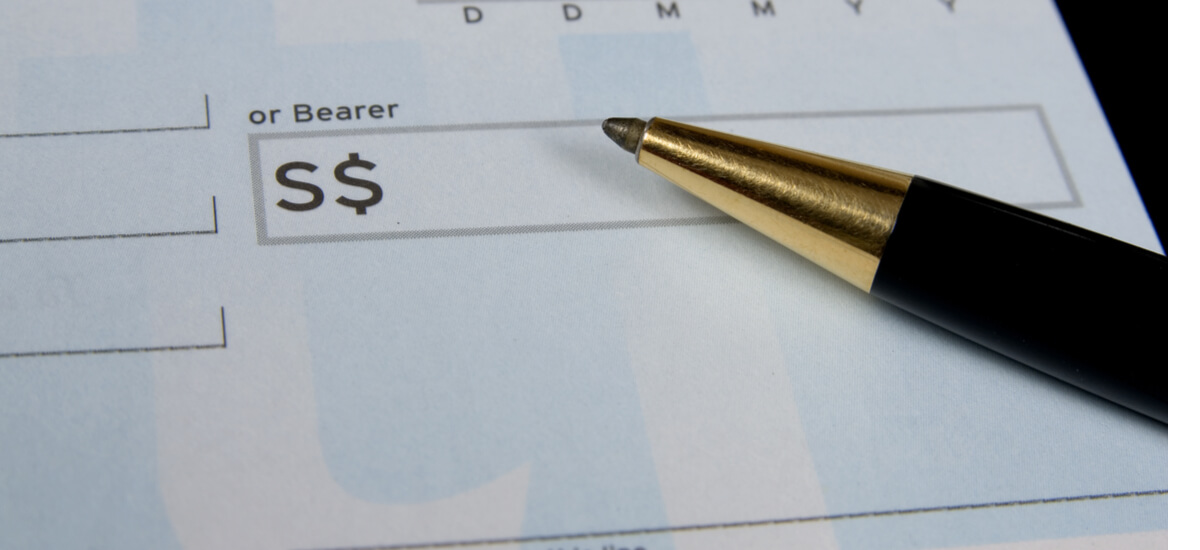Comparison of the best online brokerage accounts in Singapore
Looking for the best online brokerage in Singapore? Compare platforms like IBKR, Saxo and Moomoo on fees, features and more to find the right account.

Singapore is hoping to go cheque-free by 2025, pushing towards the wider use of e-payments.¹
But not everyone in the country uses electronic transactions, so you may still encounter the need to use a cheque. For example, you may need to pay a building contractor by cheque, or deposit a cheque you receive from a relative as a wedding present.
If you are still a cheque user, the good news is that most of the main banks still accept them. This includes POSB, DBS, OCBC and UOB.
But how do you actually write and deposit a cheque in Singapore? We’ve put together a handy refresher guide in case you’re new to the country or it’s been a while since you’ve filled a cheque. So let’s get started.
| Table of contents: |
|---|
| Wise lets you make low-cost international payments, hold a balance in 50+ currencies, get local bank details and a multi-currency debit card with no foreign transaction fee. Plus you’ll get the mid-market rate on all transactions. Take a look and see if you can save today. |
|---|

It’s relatively straightforward to complete a cheque in Singapore.
Simply follow these steps:
Fill in the date – this should be the date you’re filling the cheque, not the date you plan to give it to the recipient
Write the full name of the person or company you’re paying – as per their invoice or bank statement
Cross out ‘or bearer’² – this means that only your intended recipient can clear the cheque. To make extra sure that the bank knows the cheque is for the intended recipient only, draw two diagonal lines on the top left-hand corner of the cheque.
Fill in the amount you’d like to pay – both in numbers in the correct box, and in words under the recipient’s name. Make sure that both of these numbers match.
Sign your cheque.

The way you fill your cheque will depend on what type it is. There are two types you need to know about in Singapore – a cash cheque and a crossed cheque.
The main difference between these cheques is who can deposit each type. Let’s take a closer look…
A cash cheque can be cleared by anyone. If you don’t know the recipient’s name or it doesn’t matter, you can simply write ‘cash’ on the pay line. This indicates that whoever has the cheque can take it to the bank and cash it. They don’t need to have a bank account or have to prove that they are the intended recipient. They can simply receive the funds in cash.
If you only want a particular person or company to be able to clear the cheque, this is the type of cheque to choose. A crossed cheque is a clear message to the bank that only the recipient is permitted to deposit the funds into their bank account.
This is a smart choice if you’re worried about fraud, as it means that lost or stolen cheques can’t be cleared by just anyone. If the cheque falls out of the recipient’s pocket while walking down the street, it can’t then be cashed by a random passer-by. This provides extra protection for your money, as well as peace of mind.
To create a crossed cheque, simply follow the steps above and make sure to cross out the words ‘or bearer’. Remember to include two diagonal lines in the left-hand corner of the cheque. This is what makes it a ‘crossed’ cheque.
Received a cheque? Depositing it is a standardised process in Singapore, so it’s pretty much the same everywhere. You should find it relatively easy and quick to deposit a cheque and receive the money.
The only catch is that you can only deposit a cheque at your own bank, or a bank where you have an account. Unfortunately, you can’t deposit your cheque at the sender’s bank either.
There is an exception to this, however. For POSB or DBS bank, you can use a branch of either even if you only have an account with one. This is because DBS owns POSB.³
When you’re ready to deposit the cheque, follow these steps:
2, Visit a local branch of your bank before 3.30pm³ (the cut-off time for cheque clearing) on a business day. If you deposit your cheque after the cut-off time, it may only be cleared the day after next.
When the bank receives your cheque, they’ll usually send an image of it to the sender’s bank. This enables the sending bank to release the funds. The money is then credited into your account.
How long it takes to receive your money depends when you deposit your cheque: ³
* Monday to Thursday, before 3.30pm - clear next business day after 2pm * Thursday after 3.30pm – clear Monday after 2pm * Friday before 3.30pm – clear Monday after 2pm * Friday after 3.30pm – clear Tuesday after 2pm * Saturday/Sunday (anytime) clear Tuesday after 2pm.So, if you need the money urgently, you’d better make sure you get to the bank with your cheque before the daily cut-off time.
And remember that cheques in Singapore are usually only valid for around 6 months from the date they are written². With this in mind, aim to deposit yours sooner rather than later – just in case you forget about that cheque sitting at the bottom of your bag.
So, that’s pretty much it – all you need to know about writing and depositing a cheque in Singapore.
You should now know what to write where, and how to cross your cheque to prevent it being cashed by someone other than the intended recipient. Hopefully, you’ll find it relatively straightforward, even if it’s been a while since you’ve sent or received a cheque.
Even though Singapore is moving towards a cashless or at least ‘chequeless’ way of banking, it’s still useful to know how to write and deposit a cheque just in case you ever need to.
Sources used:
Sources checked on 21 January 2021.
*Please see terms of use and product availability for your region or visit Wise fees and pricing for the most up to date pricing and fee information.
This publication is provided for general information purposes and does not constitute legal, tax or other professional advice from Wise Payments Limited or its subsidiaries and its affiliates, and it is not intended as a substitute for obtaining advice from a financial advisor or any other professional.
We make no representations, warranties or guarantees, whether expressed or implied, that the content in the publication is accurate, complete or up to date.

Looking for the best online brokerage in Singapore? Compare platforms like IBKR, Saxo and Moomoo on fees, features and more to find the right account.

Planning a Trust Bank overseas transfer? We reveal if the service is available and compare it to a transparent, fast, and low-cost alternative

Find the best late-night money changers in Singapore with our guide. Compare rates and find out how to save on your next exchange.

Learn how to transfer money from your DBS account to GCash in the Philippines. This guide covers the steps, transfer times, fees, and daily limits.

YouTrip for overseas transfers? Learn how it works, compare features & fees with Wise, and find the best international remittance option.

Is JiPay a great money management app for migrant workers in Singapore? Read more from our review about JiPay's features, remittance and more.